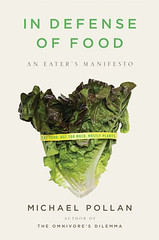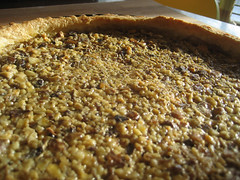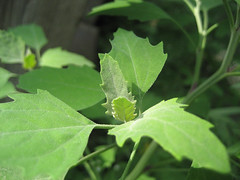
Having written about Michael Pollan’s In Defense of Food before reading it, I thought it might be nice to write about it after, too.
As noted before, Pollan— the author of the our-food-chain-is-messed-up book The Omnivore’s Dilemma— is here trying to put a positive spin on that message by showing how it’s possible to arrive at a reasonable and healthy diet by, basically, following the principle on the book’s cover: Eat Food. Not Too Much. Mostly Plants.
Pollan’s overarching target in the first half of this book is what he calls Nutritionism— the unnatural practice, as he paints it, of breaking our diets down into scientific processes. He is very compelling, first, on how this has caused a major shift in how we eat that few of us have really noticed:
In the case of nutritionism, the widely shared but unexamined assumption is that the key to understanding food is indeed the nutrient. Put another way: foods are essentially the sum of their nutrient parts. [p. 28]
This brings us to one of the most troubling features of nutritionism… when the emphasis is on quantifying the nutrients contained in foods (or to be precise, the recognized nutrients in foods), any qualitative distinctions between whole foods and processed foods is apt to disappear. [p. 32]
This is one of Pollan’s key points: an emphasis on nutrition rather than eating has actually made our food worse for us, because it strongly favors Big Food’s latest product over the little farmer and the real food from the soil. Food marketing requires novelty. Carrots are pretty much carrots, a commodity. But new Totally XTreme Asian Ranch Whole Grain Num-Os are an improvement over last year’s Partially XTreme ones, or at least they can be if some science can be rigged up to let you make a claim that they cure heart disease. And that’s what nutritionism’s reductive view of eating is: find a magic bullet, hype the hell out of it, and sell sugary salty gloppy glop because it has a supposed single virtue. A mere carrot hardly stands a chance against such marketing muscle; “the most healthful foods in the supermarket sit there quietly in the produce section, silent as stroke victims, while a few aisles over in Cereal the Cocoa-Puffs and Lucky Charms are screaming their newfound ‘whole-grain goodness’ to the rafters.” [p. 39-40]
The problem with this is not only that the claims are often dubious (he shows how malleable supposedly legally-defined terms such as “whole grain” are) but that the science underlying so much of this is, simply, bullshit. This is perhaps the most eye-opening and valuable part of the book, a long section in which he shows that, as Dr. Happy Harry Cox put it, everything you know is wrong, or rather, everything the largely self-appointed experts have told you is built on evidence ranging from flimsy to nonexistent. Take one of the things everyone knows, that a high-fat diet leads to heart disease. That’s like saying sunlight leads to plant growth, right?
In a recent [Harvard] review of the relevant research called ‘Types of Dietary Fat and the Risk of Coronary Heart Disease: A Critical Review,’ the authors proceed to calmly remove, one by one, just about every strut supporting the theory that dietary fat causes heart disease… Only two studies have ever found ‘a significant positive association between saturated fat intake and risk of CHD [coronary heart disease]’; many more have failed to find an association. [pp. 41-3]
But at least we know that high cholesterol is bad, right?
As for the dangers of dietary cholesterol, the review found ‘a weak and nonsignificant positive association between dietary cholesterol and risk of CHD.’ [p. 43]
Still, encouraging us to replace all that fatty red meat couldn’t have been all bad– it’s not like what we ate instead could have been worse for us:
By the end of the review, there is one strong association between a type of dietary fat and heart disease left standing, and it happens to be precisely the type of fat that the low-fat campaigners have spent most of the last thirty years encouraging us to consume more of: trans fats… the principal contribution of thirty years of nutritional advice has been to replace a possibly mildly unhealthy fat in our diets with a demonstrably lethal one. [p. 44]
If this were fully recognized for what it is, it would be considered one of the great government screwups of all time, nutritionism’s Vietnam. In the late 70s government started encouraging us all to eat in a new way, eating less fat and, more importantly, different kinds of fat. The “low fat” or “lipids” theory was embraced by food companies and is evident in thousands of products at every supermarket today. Yet what was supposed to make us thinner and healthier instead has made obesity, diabetes, every “disease of affluence” far more prevalent. It has blown the O-ring on American health and sent its flaming wreckage spiraling toward the ocean. It has done exactly the opposite of what it was supposed to do, and in a real sense the famous joke in Woody Allen’s Sleeper has proven prescient:
Dr. Melik: This morning for breakfast he requested something called “wheat germ, organic honey and tiger’s milk.”
Dr. Aragon: [chuckling] Oh, yes. Those are the charmed substances that some years ago were thought to contain life-preserving properties.
Dr. Melik: You mean there was no deep fat? No steak or cream pies or… hot fudge?
Dr. Aragon: Those were thought to be unhealthy… precisely the opposite of what we now know to be true.
But at least from a food marketer’s, or a diet book author’s, perspective, it’s been an enormous success, because it’s created a massive market whose hunger is limitless for new products– which have the tremendous benefit, from a marketer’s point of view, of never working.
* * *
So if nobody knows nothing, what the hell do we do now?
Pollan starts by suggesting that we back our way out of the nutritionist mindset and accept that we just don’t know what we don’t know about how food works. The search for magic bullets has been a red herring, we just don’t know how the combinations of foods produces healthful effects, eating one thing to produce one result almost never seems to work. We’re in the dark ages still on this stuff.
But what we can reasonably deduce is the basic validity of things like the French paradox– that if we need complex combinations to produce a fully healthy diet, then the traditional diets of most cultures have evolved to provide such combinations. As he points out, nearly every culture, whether they eat lots of vegetables or nothing but meat and blubber, manages to have roughly the same low incidence of diseases of affluence– except us. Only we managed to create, scientifically and industrially, a diet that so overdelivers on the things humans crave that it causes us problems.
This is where the advice to eat nothing your grandmother wouldn’t recognize comes in. Basically, he says, if you eat real foods from before the days of food science, you should wind up with a diet that reflects cultural knowledge of what makes you healthy.
The problem with this is that the apple’s been eaten and we can’t go back to Paradise. Once we have knowledge of Mexican and Thai and sushi, we’re not going to be happy living on an American farm diet full of English or Germanic touches circa 1910 (which would probably be what most of us, strictly choosing to eat like Grandma, would wind up with). But the danger of being an omnivore is that in choosing to eat from many cultures, we’ll wind up cherrypicking the most appealing foods from those cultures– and miss out on the balance part.
To my mind, the grandmother advice doesn’t really work, except as a reminder to keep a skeptical eye toward the new foods (or, as Pollan calls them, edible foodlike substances) that pop up every year in the supermarket. The other problem is that the foods in the supermarket aren’t themselves any more, anyway. Grandma might recognize a steak (though it’d look pretty darn lean to her) but its cornfed taste would seem very odd. And that difference conceals the fact that a cornfed steak is lacking precisely the omega-3s that were one of a grassfed steak’s contributions to your balanced diet and health. It really isn’t the same food it was in her day.
Nevertheless, Pollan does try to identify some basic principles which, if followed, will help you generally work your way toward a diet as balanced and healthy as Grandma would have recognized:
Shop the peripheries of the supermarket and stay out of the middle. [Since the real stuff tends to be along the walls, and the fake stuff is in the center.]
Avoid food products that make health claims. [If it had to be engineered and tested, it’s too fake to be part of a balanced Grandma diet.]
Eat meals. [Grabbing a sack of food and wolfing it down in the car, or grazing all afternoon, is not a meal. The way the French sit and eat for an hour and a half has all sorts of mechanisms built into it to provide satisfaction and feedback without stuffing yourself silly.]
These principles are the way Pollan avoids falling into the trap he’s set for himself, which is being someone who’s just condemned nutritionism, and then proceeds to write a diet book. There are no recipes and no weight-loss schedule here– which is why it’s all the more startling when he suddenly turns up advocating we all take supplements. Isn’t that exactly the kind of nutritionism, healthy eating reduced to a pill, that he’s been against in the rest of the book? It may be good advice for the middle-aged, but so is making sure to invest in your employer’s 401k, that doesn’t mean it belongs in a book about looking at eating as a part of a rich and happy life, not as a system of self-medication.
One principle is perhaps the most thought-provoking: Eat less and pay more. It’s not that paying more is exactly a positive good, but until you know you’re paying more for your food and spending more time preparing it, you’re not getting the stuff that’s better for you, better for the farmer and the food chain. If it’s cheap and convenient, there’s something wrong with it, is Pollan’s basic point. To be that cheap, it must be being grown in a way that’s less than ideal.
* *
In warning us against the latest breakthrough in nutrition science, Pollan runs the risk of being exactly that— this season’s Scarsdale Diet or The Zone or South Beach, the book that finally Explains It All… until the next one. And in reviewing it, I run the risk of becoming the acolyte who has Found the Answer… until the next book.
Yet I think the first half of the book, demonstrating how completely farbungled our dietary situation is, thanks largely to science and experts who were just plain wrong, is extremely important— a key text of American skepticism and debunking, up there with Mencken and Jessica Mitford, if not as wittily written.
And the second half, if not entirely news you can put to use today, thinks seriously and practically through the issues involved in trying to get back to a more sensible way of eating in today’s world, as it’s just becoming possible enough to actually do it thanks to farmer’s markets and CSAs and so on. It may not be possible to live entirely according to Pollan’s principles yet, without growing it all yourself, but living according to as many of them as you can will make that day come a little closer, and probably make your meals taste better— even as they also take longer to make and cost you more.



 Posted in
Posted in 






